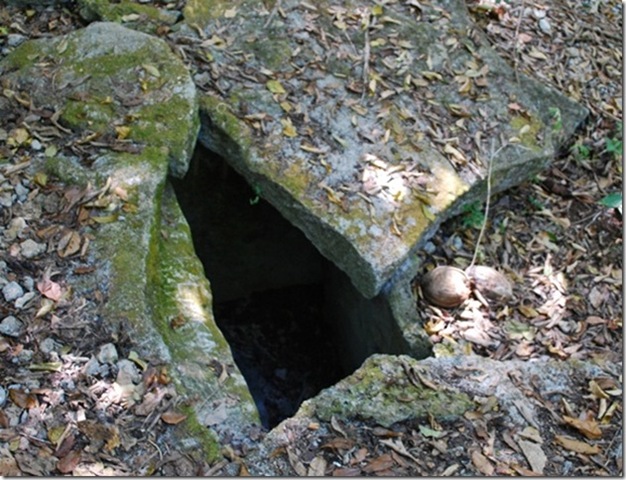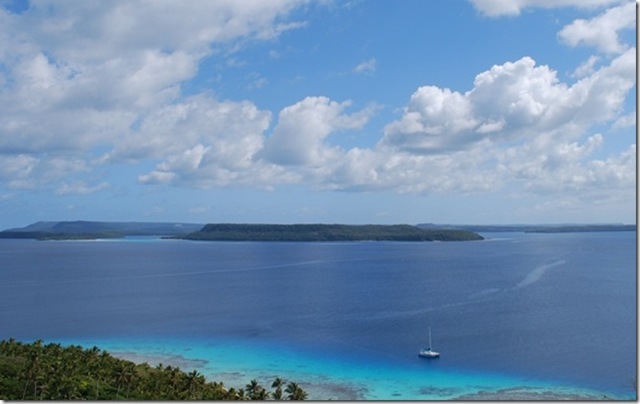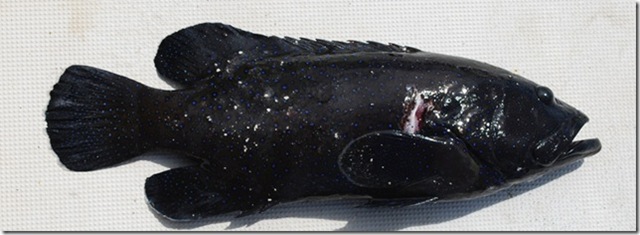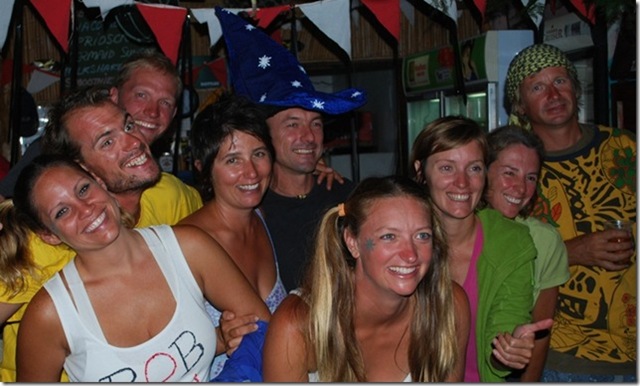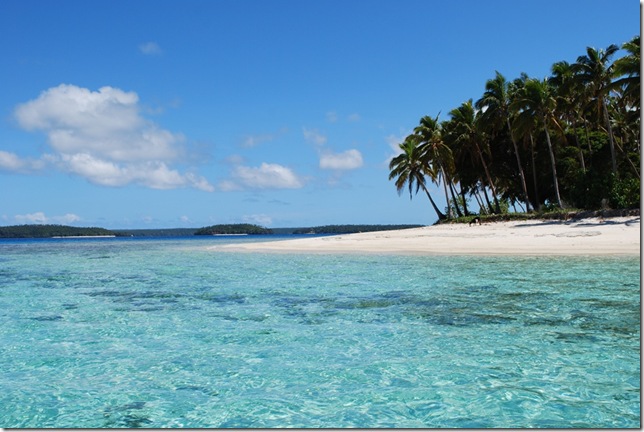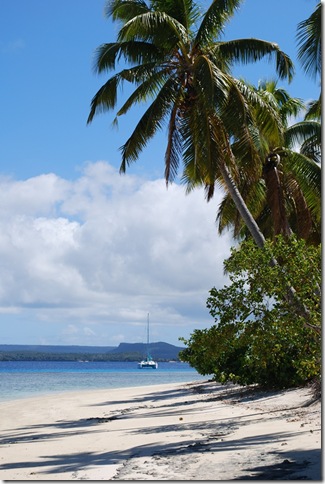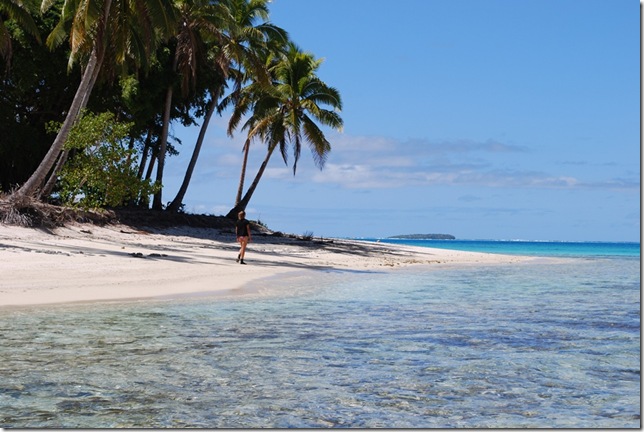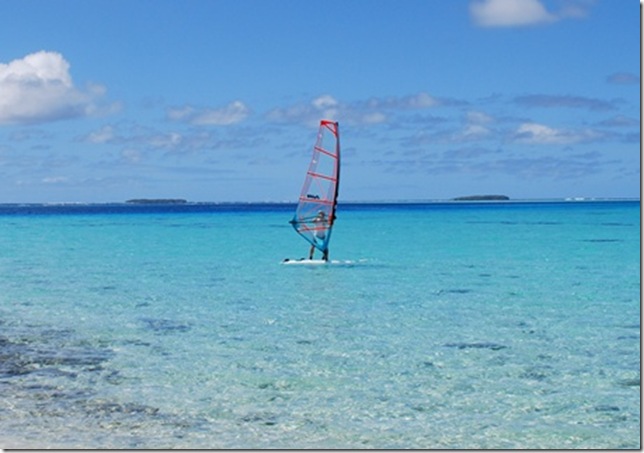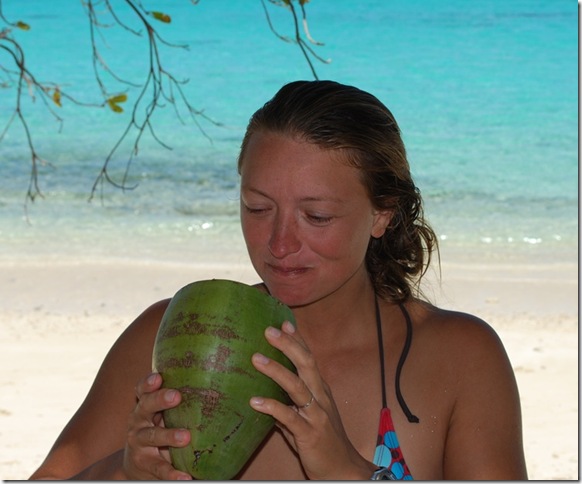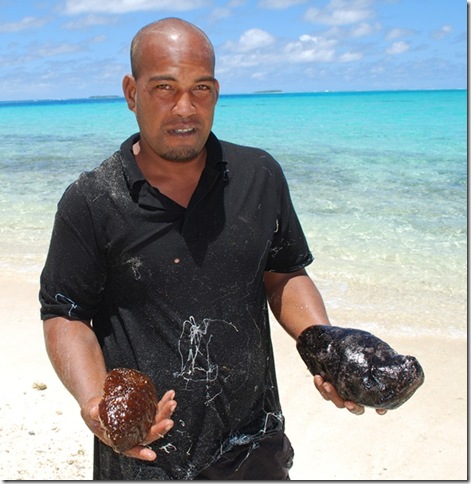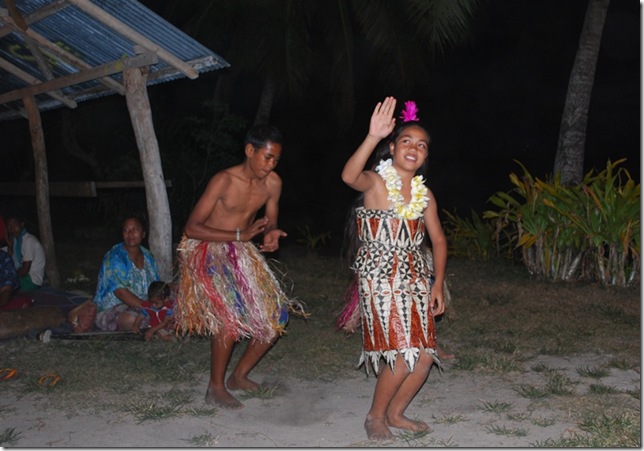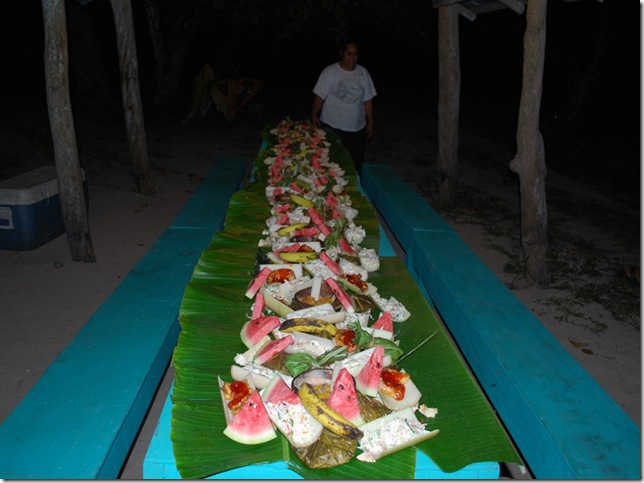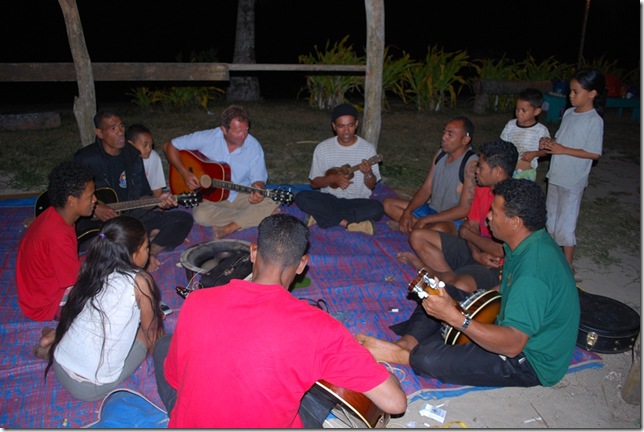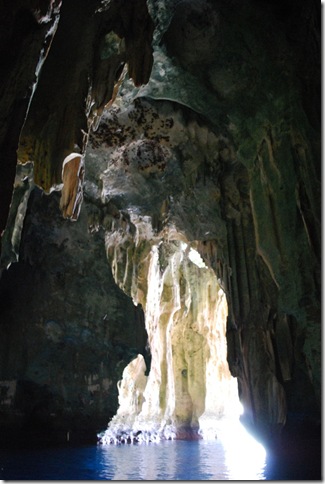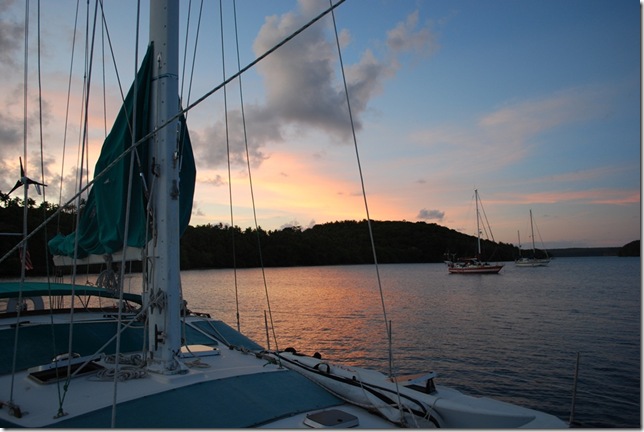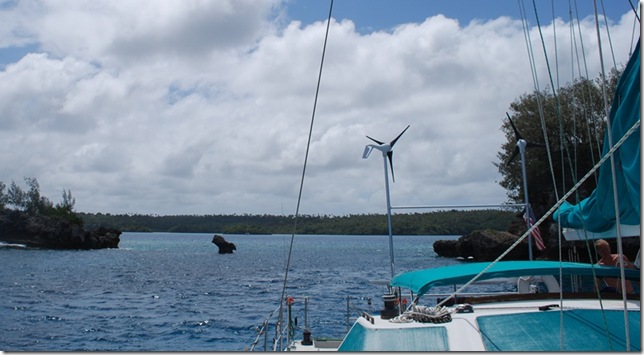Thursday was a busy day at Euakafa Island (#32). Dallas and I awoke early and climbed 300’ to the plateau at the top of the island. It was a fairly quick and easy hike to the top amidst a forest of varied foliage that characterizes the islands of Tonga. Near the top we located the open tomb that was mentioned in the cruising guide. Apparently it was the final resting place for a Tongan queen whose life was cut short by the chief’s henchmen as a result of her infidelity. We headed on up to the viewpoint at the top where we could see our boat and two others anchored in the clear aquamarine water surrounded by the deeper blue sea dotted with green islands. Unfortunately, we neglected to put the camera battery back in the camera after charging it, but Wes and Tiff hiked up the next day and snapped some really nice shots. I have to agree with the cruisers who refer to the Vava’u group of Tonga as the most idyllic cruising grounds.
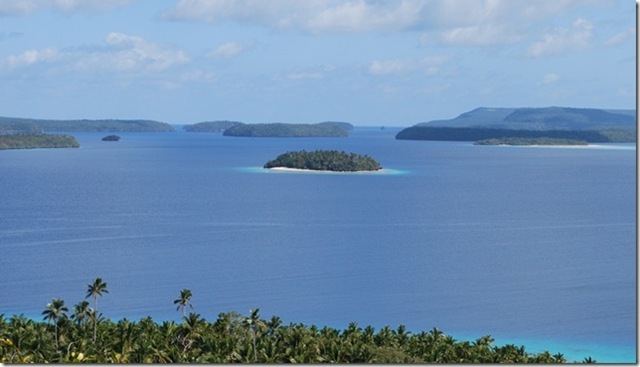 Neighboring islands of the Vava’u Group
Neighboring islands of the Vava’u Group
We returned to the boat to grab a quick snack and get our snorkeling gear, and then it was off to join the guys from the other two boats in trying to spear some fish for lunch. We all came back empty handed, blaming it on the dwindling fish population in Tonga, but Wes proved that it could be done by spearing a grouper later that afternoon.
Next it was time to get serious about preparations for the passage to New Zealand. I volunteered to do one last bottom-cleaning before the infamous bottom inspection by the NZ officials. (For the land-lubbers who may be a little perplexed right now, I’m talking about cleaning algae/barnacles off of the bottom of our boat, not scrubbing my backside!) I assumed that this would be relatively easy since we just cleaned the bottom in Niue, and it was, but after another couple of hours in the water, I was exhausted! Dallas was as well after rounding out the day by changing the oil on both engines. If we can keep this up, though, we should be ready to set sail early next week.
On Friday we continued our preparations by finishing up the bottom cleaning and practicing deployment of the sea anchor, a small parachute that is extended from the bow of the boat on 600 feet of nylon line. Its purpose is to keep boats virtually in place for reasons such as providing crew with a break from sailing and preventing collisions with reefs. We have never considered using it before but anticipate that it could be useful en route to NZ by allowing us to wait for rough weather to pass before proceeding.
Next it was time to head back to Neiafu for the final regatta of the 2009 cruising season. The local yacht club has been coordinating these friendly races on a weekly basis throughout the season, but this particular one was quite hyped up, leading 15 boats to participate. We weren’t planning on racing initially but were lured into it by an official challenge from our Swedish friends on S/V Disa. We recruited 13-year-old Lisa and her father from S/V Anyway and another friend to crew for us, and they were not only great sailors but really pleasant company as well. We sailed quite nicely upwind, topping off at about 7 knots, but as expected, most of the other boats were much faster in light winds. Those of us at the back of the pack (basically us, Disa, a couple of larger but heavy monohulls, and a tiny one) weren’t able to finish before the wind died altogether. There was not so much as a breeze as we struggled to cross the finish line, so it wasn’t very glorious but fun nonetheless.
 Catching up to Disa just ahead
Catching up to Disa just ahead
The subsequent Halloween party at the yacht club lived up to the hype as well. Of course costumes were encouraged (especially for the ladies…wonder why?), and Tiff and I made use of our limited available resources to dress up as the "Bob Sea Twins" with pigtails and matching tanks/jeans. It should have been adequate to get us a free rum punch were it not all gone by the time we got there. It was another late night for she and I as we whiled away the hours dancing to overplayed American top 40.
We met the crews of S/V Avel Mad and S/V Rusalka in Aitutaki
We’ve taken it pretty easy today, getting small tasks done (printing boat documents, going to the market) and going out to lunch with the brothers from Disa. Leo was a little bummed about losing his home-made lobster cage, thought to be sitting on the bottom 20′ below their boat. He would have gone to look for it were it not for his eardrum perforation problem, so I offered to fill in. The poor visibility (much different from the clear water of the uninhabited anchorages) prevented me from seeing the cage from the surface, so I used one of our scuba tanks to explore the bottom and located the cage just 10′ or so from where it likely went down. Leo was really pleased to have his cage back, and I could understand why after seeing the craftsmanship involved. He is hoping to use it to attract some unwitting lobster using Vienna sausages as bait. He was advised that dead fish might work better, but none of us have any laying around at the moment. With any luck he can snare a lobster with a diverse palate.
Tomorrow we will get more use out of our scuba gear, as Dallas and I are going to make good on our offer to help out the couple living on the floating house/art gallery at anchorage #11 by working on their moorings. I’m sure we could find plenty to do here in Tonga for many weeks, but we have to wrap things up and get ready to move on.
After a short stop in Neiafu for provisions, internet, water, and hanging out with friends yet again, we headed back out to the islands. The first stop was Avaldu Island (anchorage #40). Avaldu rests behind a large reef about a mile or so to the south, so the water is fairly calm. It’s uninhabited except for a small herd of goats, and has a beautiful beach on its west and south sides.
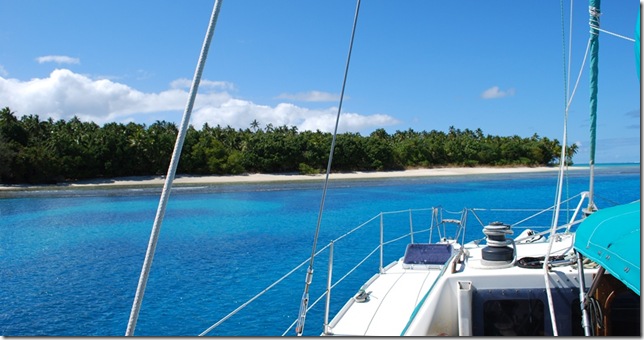 View of the beach from the boat
View of the beach from the boat
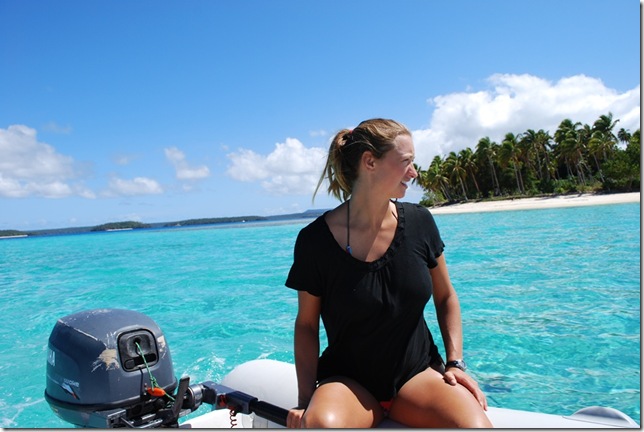 Lauren bringing us in to windsurf
Lauren bringing us in to windsurf
The French boat S/V Avel Mad joined us, and Ben is a good windsurfer. Since we had a nice beach with shallow water, the wind blowing us back toward land, and a day with no other exploring planned, we finally pulled out the windsurfer for a long overdue second lesson. Ben got us back up to the point we were after our first lesson with Ken back in Florida (more falling off than anything, but getting close to starting to sail), and the next morning we headed back to the beach for another round. This time, Lauren and I both did much better. The winds were light, and we need some more tips on what to do once you’re actually able to stand up with the wishbone in your hands, but we both sailed a short distance. I made it about 100 feet in the light winds, and found that being right-handed, the starboard tack is easier for me — it took me several tries to sail back to where I’d started.
While I was taking a break on the beach, a local swam around the southeast top of island and up to the beach dragging a couple of old rice bags tied to an empty anti-freeze bottle acting as a float. His name was Gopo and he was collecting cuttlefish to sell in Neiafu (8 panga each) where they’re apparently sold as a food item to Chinese buyers. While we explored the interior of the island a bit, he collected a number of young, green coconuts for us. The young, green ones are a bit harder to find but make a delicious energy drink. Gopo opened a couple of them, and they really hit the spot after a couple hours of trying to windsurf. We gave Gopo a ride in our dinghy out to the next reef so he could continue his collecting and then motored toward his friends on the fishing boat to signal to them and let them know about his new location. On the way back to the beach to pick up the windsurfer, I saw a whale off in the distance on the other side of the reef. Humpbacks are quite common here, and this one shot up into the air, looking like a submarine shooting up from deep water. It landed with a huge splash that dwarfed the breakers at the edge of the reef. It made a nice rolling fin-slap afterwards and then we didn’t see it again.
We made a short afternoon sail over to Euafaka Island (#32), following Avel Mad to our next stop as well. We arrived in a napping mood, and decided to leave exploring for the next day. Wes and Tiff came up with the idea of a nice dinner on the beach with a bonfire, so we all headed ashore with our food and wine in the cooler to enjoy a bonfire and dinner. The seemingly dry leaves here don’t light and burn quite as well as they did back home, so we enlisted the locally-used fire-starter — gasoline. A little gasoline from the dinghy on a paper towel did nicely and we soon had a nice little fire. Wes did a nice job providing music by connecting an FM transmitter to an mp3 player so we could listen to our own private FM channel on one of our radios. While we were enjoying the moonlit evening on the beach, we noticed lights in the water near our boat.. At first we thought maybe they were reflections of the moonlight or phosphorescence, but after a minute it was clear they were flashlights. Apparently the locals we had seen at the other end of the beach when we landed were swimming their way around the island’s fringing reef looking for lobsters. For the landlubbers, lobsters generally hide during the day and come out at night to scavenge, when they’re easily spotted crawling along the bottom, with eyes that reflect light like a specially coated highway sign.
The wind died almost completely while we were ashore, and when we returned to the boat, it was a really a beautiful sight. The water below the boat was nearly 30 feet deep, but it was so calm and clear that the gibbous moon provided enough light to see the rocks, coral, and contours on the bottom. It was like a real-life version of one of those paintings that shows the underwater view beside a beautiful beach and island above it. Of course there weren’t three dolphins, a whale, two manta rays, a starfish, and a sea turtle in view all at the same time like in the whimsical paintings, but it was a memorable sight nonetheless.
After a nice night in the cove by Lisa’s beach, we slowly got moving toward anchorage #11, near Ano Beach. Along the way, we stopped near Mala to anchor for lunch and a bit of snorkeling. When she got in, Lauren checked the anchor, and found that it wasn’t buried in the sand but had just snagged a piece of coral. We were only planning a short stop since it was an exposed, shallow area with a nearby lee shore, but it’s still nice to know what the anchor situation is. As usual, It held with no problems but it’s amazing how worried I’ve become about holding after dragging once in an anchorage with poor holding.
Lauren and Tiff tacked into the wind until we were just off of Ano Beach. They did a great job, but I did get a bit of a surprise when I woke up from my afternoon hobby and saw we were within a hundred feet or so of a cliff and getting ready to tack to back out. We dropped anchor in the bight to the east of Ano Beach, and waited as a steady stream of boats started coming in before sunset. Several of our friends made the trip over for the Tongan feast and it was nice to hear them on the radio and then see them pull up and drop anchor.
In all, about 25 people showed up for the Tongan feast, which started with some locals selling handicrafts while others started playing traditional music around a bowl of kava. The feast is a family business put on once a week in an outdoor beach setting, Things get started with several rounds of kids dancing while adults sit on the ground behind them drinking kava, playing guitars and wooden percussion instruments, and singing. The kids are good spirited and talented, with a nice variety of expressive dances. One of the boys ended the entertainment with some fire dancing, which was pretty impressive for someone his age. After the dancing, we settled down at the table setup under a tin-roof structure for the feast. There was raw fish, fried fish, fruit deserts, banana bread, corned beef, etc. Although there were some modern food selections, the presentation as very traditional. Banana leaves were used as tin foil, wrapping the baked items like banana bread and corned beef. The raw fish and cooked chicken dishes were served on sections of banana stalks cut in half to form a serving dish, and in the Tongan style, there was no silverware – all eating was done with bare hands. Afterward, the there was a short song session with Martin, some yachties, and the local musicians. As the next day was Sunday and the locals had to return home early, we had the beach to ourselves and enjoyed a nice bonfire on the beach until late into the night.
At the south end of the anchorage are some moorings an artfully painted, light blue floating home called the Ark Gallery. Larry and Sheri, two former cruisers from the US live there, rent the moorings, and sell Sheri’s painting as well as a few local handicrafts. We’d stopped the day before to have a look and we returned in the morning to select a painting and pick up a postcard. We had a nice conversation and the topic eventually turned to the New Zealand passage. Larry has done the passage 10-15 times, and feels that the cruisers these days leave much too early. Like others, he also told us that Haapi was nice (a more remote Tongan island group about 80 miles south) but that Nuku’alofa could be skipped without missing much (the Tongon capital about another 80 miles south of Haapi). It’s a large city with a small, crowded harbor and lots of unemployment. He also pointed out a couple of nice spots to visit that we haven’t seen yet.
After talking with Larry & Sheri, we went back to the boat and on the way back to Neiafu we all decided to spend the rest of our time in the islands in Vava’u and leave for New Zealand from here. It only adds an extra day or so to the trip and we still have plenty to see and do.
On the way back to Neiafu, we also stopped at Swallow’s Cave. Many of the islands here in Vava’u are limestone from upraised coral formations. Although the caves and cliffs aren’t generally as picturesque as Niue, they are pretty. Swallow’s Cave is a large cavern than you can row the dinghy into. There are nesting birds on the ceiling (apparently actually starlings instead of swallows) that were swooping in and out of the cave as we took turns paddling in while the other couple stayed to tend the drifting boat (even within one boat length of the cliffs, the water is more than 150 feet deep). Inside, there is a lot of graffiti (some of it dating back well into the 19th century), but but it doesn’t hide the beauty of the cavern with it’s vaulted limestone ceiling and elegant features or the incredible clear and glowing blue of the water below.
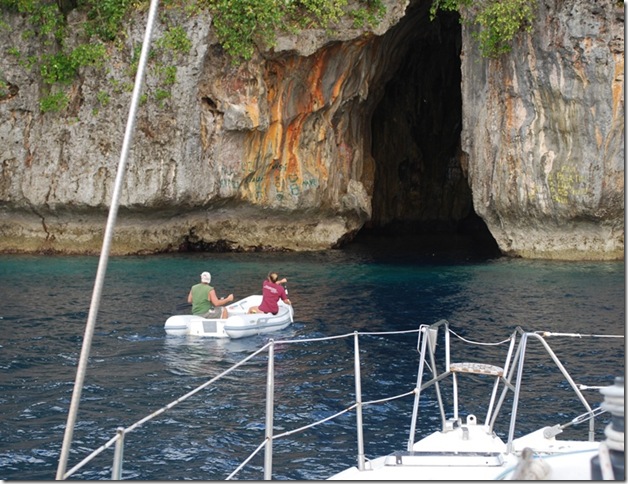 Wes & Tiff paddling toward Swallow’s Cave
Wes & Tiff paddling toward Swallow’s Cave
The only bad thing about Tonga is that there are so many cruisers here that we’ve met along the way or have gotten to know here that we are missing out on interacting with the locals. Even many of the waterfront businesses that cater to cruisers are run by expats.
Even though it’s a 2000+ nm detour for most circumnavigators, New Zealand is a popular cruising destination. In addition to providing a good place for boat repairs and offering natural and cultrual tourist attractions, it is almost completely out of the hurricane region of the South Pacific, making it a safe place to spend the hurricane season.
The passage there and back, however, has a bad reputation among sailors for being rough and potentially dangerous. When to make the passage and how to approach it is a common topic among cruisers this time of year. Although people who make the trip regularly or have a number of New Zealand passages under their belt seem to think it’s not too big of a deal, those of us who haven’t done it yet are all a little nervous. We’ve spent several months in the reasonably-predictable tradewinds and sailing to such a high latitude is always more uncertain.
The weather worries have a couple of sources. The first is that weather forecasts are usually only reliable for 3-5 days, after that, they’re much less accurate and anything over a week seems to be more like an educated guess. Most boats make 100-150 nm a day and the passage to New Zealand is about 1000-1200 nm. When heading southward, this means that you’re leaving the tradewinds and heading into the region of variable winds right around the time your departure weather forecast is getting stale, so can’t be sure what you’re going to get — calms, wind on the nose, a nice beam reach, or a SW gale. The timing of the passage is also a topic of discussion. The southern hemisphere seasons are changing from winter to summer. If you leave too early, you’re pretty much guaranteed a stong SW winter gale at some point. If you leave too late, you could be risking a hurriance either where you’re waiting to depart or possibly along the way. Hurricanes in November are rare, but they do happen, especially in El Nino years (this is currently a weak El Nino period). Winter storms are a guarantee in October, and summer weather starts to really settle in during December. Although the conditions may be uncomfortable, they’re generally not unsafe, although there have been a few occasions when boats on passage to or from New Zealand were hit with very strong, unpredicted winds from a quick-forming tropical storm or a “squash zone” (compresed isobars and high winds between nearby low and high pressure zones).
Advice based on absolutely avoiding hurricanes says to leave by the beginning of November, but the experienced sailors we’ve talked to say that the better passages are made later, sometimes well into December, albeit with some hurricane risk. It’s tempting to stay in beautiful and comfortable Vava’u, but we’re sticking with our original plan of leaving during the first week of November. Our plan, like that of many others we’ve spoken to, is to use modern communications and weather forecasting to our advantage. We’ll try to time our departure for a weather window that looks good, but we’ll also be updating our forecast information along the way. If it looks like a gale is coming to the area north of New Zealand, we’ll drift, heave-to, or set our sea anchor for a couple of days and let it pass in front of us before continuing. We’re also carrying plenty of fuel, changing the engine oil before leaving, and we’ll be much more ready to motor if the winds are light or contrary. We have roughly an 800 nm range under power, although hopefully we don’t have to motor anywhere near that much.
The weather forecast for the next week shows lots of wind on the nose south of the tradewinds — weak winds from a high and then strong SW winds as a low moves through. We’re hoping that next week looks better.
Wednesday morning we took a short dinghy ride over to the beach at the northern tip of Vakaeitu so that we could explore the reef that runs between Vakaeitu and Nuapapu. We spent an hour or so swimming out to Nuapapu and back along the reef, amazed the whole way. It is by far the most alive and colorful reef we’ve seen, with the hard coral spread out below us in a dazzling array of textures, shapes, and colors. Almost every color imaginable was present, with many types of coral showing multiple colors when we dove down to have a closer look. My favorite was probably a deep but bright blue, almost indigo colored coral that looked like antlers growing out from the reef. When you dove closer to it, you could see the “antlers” were covered in small spherical features. There weren’t a lot of fish, but the ones that we did see were pretty colorful. We saw a lot of familiar species, and a couple of new ones. One funny-looking type was colorful with a long snout that looked sort of like an anteater’s nose.
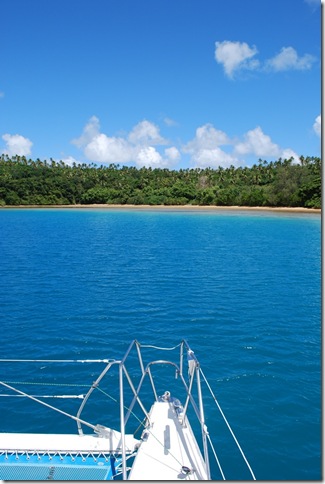 The beach at the bight of Vakaeitu
The beach at the bight of Vakaeitu
I spent the afternoon on a long-delayed project — the port head. It’s an electric one and has gradually gotten to the point that it was almost unusable. Eventually the blockage was found in the tapered plastic elbow at the head itself (of course I started looking at the other end). The 1 1/2″ pipe was clogged by build-up down to about 1/4″. Quite a messy afternoon, but the good news is that instead of having an expensive or tedious pump problem to deal with, we now have “turbo-head” back. You are your own plumber out here. I also fixed one of the forward bimini mounts, which had been pulled loose by an enthusiastic but not so sure-footed dancer on Sunday night.
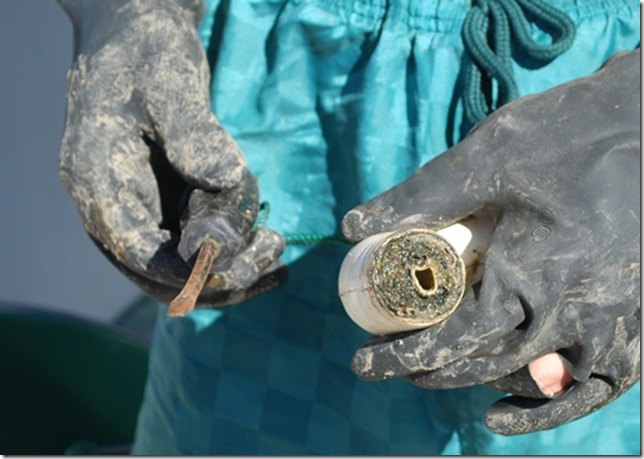 Just another day in paradise, eh?
Just another day in paradise, eh?
A good part of the appeal of Vava’u for sailors is the large number of small islands and reefs all clustered together. In addition to being beautiful and providing many quiet spots to anchor, the sailing within the group is often very pleasant, with nice tradewinds and calm, protected waters. You can easily sail anywhere within the group during the day, and moving anchorages often only takes a few hours.
 A typical scene, three boats under sail in the protected waters of the Vava’u group
A typical scene, three boats under sail in the protected waters of the Vava’u group
Thursday morning we headed for the southwest tip of Vakaeitu, where the boat anchored beside us had told us we could find some great coral walls for a scuba dive. Lauren and I spent about 45 minutes exploring the coral-covered walls. The coral was very similar to the day before, but with tanks we had time to explore it up-close and a a very leisurely pace. The terrain was incredible. Lauren described it as a fantasy-land, a combination of steep cliffs and rolling hills covered in many colors of healthy hard coral.
After our dive, we tried out anchorage #13, a sort of lagoon in the island of Hunga. A front was crossing Tonga, so the weather was windy and cloudy on the way, but luckily there was no rain. You enter into the Hunga lagoon through a narrow pass between two cliffs with a large rock near the middle of the channel that makes it not more than 50 feet wide. Inside, the water is mostly deep, but there are some shallower spots for anchoring near the edges and near two small islands in the middle of the lagoon. It’s another pretty spot, a deep-water lagoon surrounded by small mountains, cliffs, and beaches. The other nice feature of #13 was that S/V Anima was moored around the corner, so we were able to fit in some band practice with Martin on Thursday night.
The next morning, the sky had cleared with the passing front, but the winds remained and we set off to sail mostly into the wind to try out the anchorage at “Lisa’s Beach” (#10). We had planned a snorkeling stop on the way, but with the wind and occasionally overcast skies, we decided not to stop. I had started the trip under power, and was feeling a little tired and lazy, so I hadn’t set any sails, especially since the majority of the trip was right into the wind. I asked Lauren to stand watch for a while so I could catch a short nap, and the next thing I knew, she had killed the engine, unfurled the jib, and was doing a beautiful job of tacking eastward between the small islands and rocks. I was impressed. I guess I’ve been reduced to taking naps and fixing the head, which is a good deal overall.
Lisa’s Beach is a quiet, protected cove, and aside from a mega-yacht around the corner, we had the place to ourselves. We took advantage of the few hours of daylight we had left to go ashore and explore a bit. Large sections of the interior of the island are devoted to agriculture — we saw coconuts, taro, bananas, papaya, kava, and cows. It appears that the farming is done by hand, as we saw several men working in the small fields and one walking home with a machete and pitchfork. That would make for a long, tiring day.
Everywhere we’ve gone, the people have been friendly, and the woman living in the small house in the cove here came out to chat with us when we beached the dinghy. There’s a cliff right behind the house, and they have to walk a fair distance up the cliff on a concrete stairway before reaching the top where they could park a car. Her husband wasn’t home, but she invited us to a barbeque he was planning that night with a friend. We didn’t return until after dark, and it looked like the barbeque was scratched, but she still came out to say hello again and see if we were staying long enough to eat with them another night. We would probably join them if the four of us didn’t already have plans to attend a traditional Tongan feast tonight at anchorage #11.
If the weather cooperates, it looks like we’ll be here through Monday, when we’ll head south for Nuku’alofa with a possible stop in the Haapi group.


